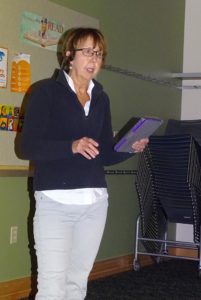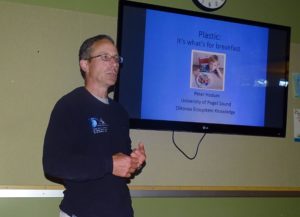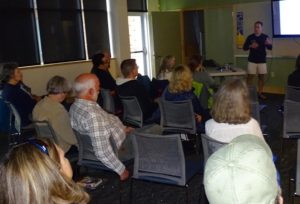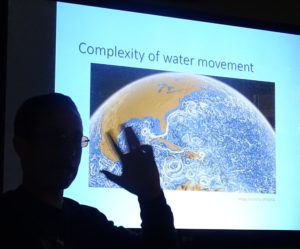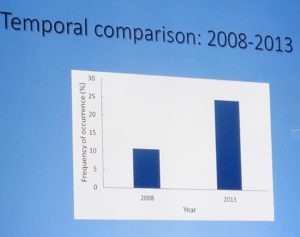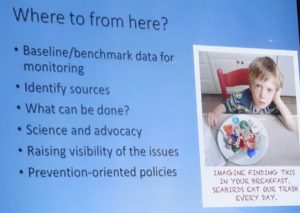-
ABC WELCOMES BACK PETER HODUM, JUNE 14, 2016:
Dr. Hodum from UPS came back for the third time and promised us another visit the next year, which we will hold him to. His first visit was about his work as a seabird ecologist and conservation biologist on Chile’s Juan Fernandez Islands in conjunction with Oikonos Educational and Conservation project, of which he is a founder (http://oikonos.org/). Then he came back and talked about seabirds nesting off the coast of Washington and educated us that Rhinoceros Auklets are really Puffins. Now for his encore he talked to us about a passion he never imagined he’d have — the growing problem of plastics littering the earth and especially the ocean where now most seabirds as well as their forage fish and benthic (had to look that one up!) prey have plastic debris, macro-, meso-, or microplastics, in their guts. The earth is now a “plastisphere.”
Peter talked the ocean currents inevitably spreading the plastics and pointed to a map, telling us it’s better as an animation.
NASA actually has a series of animations collectively called the Perpetual Ocean, which are absolutely fascinating. Study these before you send a message in a bottle:
http://svs.gsfc.nasa.gov/vis/a010000/a010800/a010841/index.html
The currents do demonstrate a likely scenario for the formation of ocean garbage patches that have been talked about a lot lately. A question from the audience elicited that Peter doesn’t think these can be cleaned up with the engineering, money, or the will currently out there, but doesn’t discount future cleanups. His current advice is to take responsibility for the plastic you put out there.
Northern Fulmars and Sooty Shearwaters were used as examples of two species that surprisingly have quite different foraging habits, especially relating to the depths at which they collect food. This corresponds to different plastic types (including different colors!) and different amounts found in each, with almost all Fulmars, feeding on the surce, found with plastics, corresponding to just under 60% of deeper diving Shearwaters.
Forage fish were found to have mostly filament-type micro-plastics ingested, which of course continue to degrade, but stick around in the birds that prey on them.
The most chilling statistic of the evening was a simple bar chart showing real differences on an upward trend since 2008 in ocean plastics (frequency of occurrence).
Peter finished up by talking about what we can do with his own targets of science and advocacy among them. He did not condemn plastics en masse, realizing how vital they are to our lives in so many ways, but urged responsible use and disposal.

